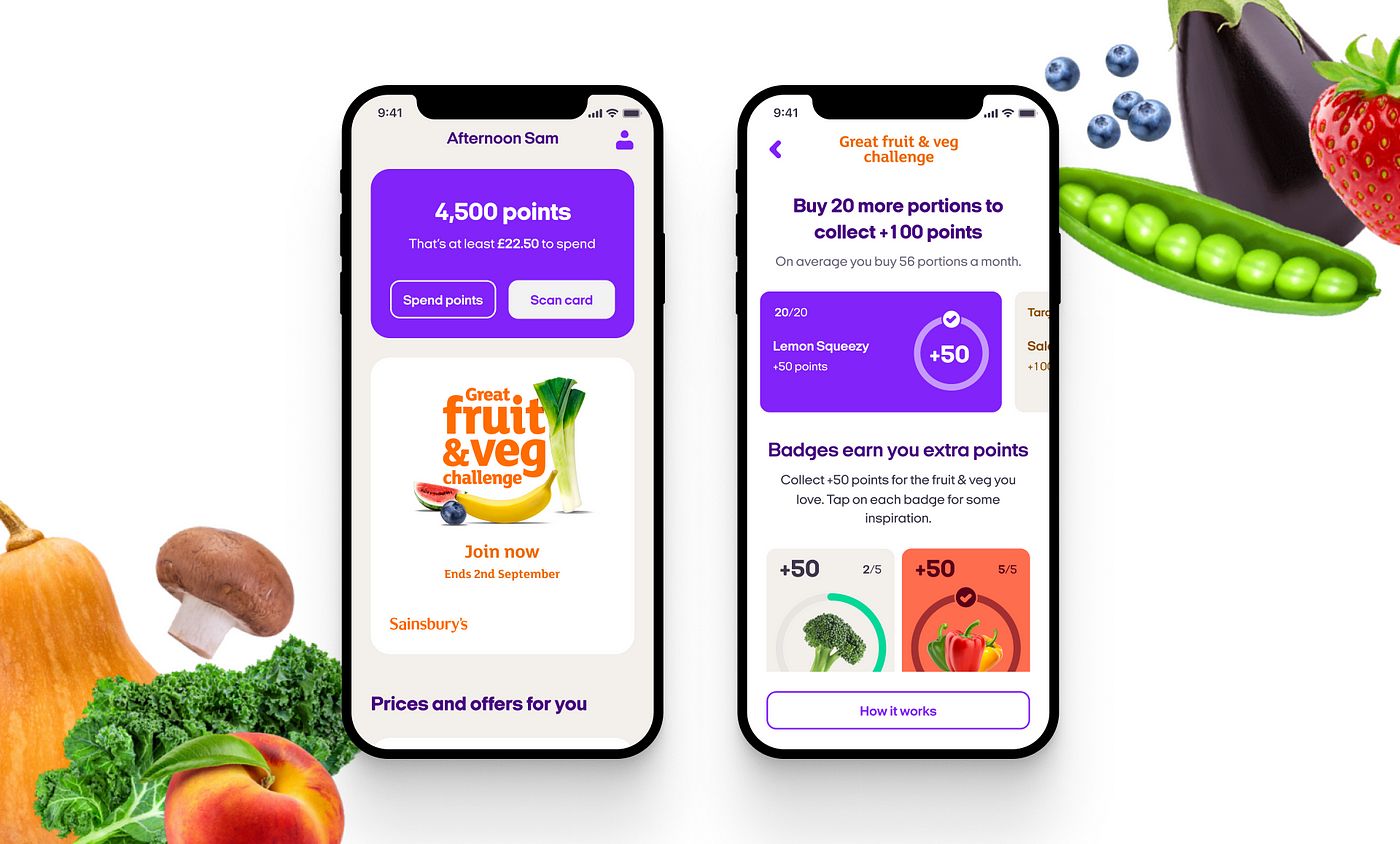Context
Sector: Groceries, loyalty program
Sainsbury’s, is a British supermarket and the second-largest chain of supermarkets in the United Kingdom, with a 14.6% share of UK supermarket sales, and Nectar is a loyalty card scheme in the United Kingdom run by Nectar 360 Ltd, a company wholly owned by Sainsbury’s. The scheme is the largest in the United Kingdom
As part of Sainsbury’s mission “Helping everyone eat better” the company decided to focus on campaigns to encourage users to make healthier choices not only for customers, but also for the planet, with this the Fruit & veg challenge was created.

“We want to encourage customers to make food choices that are both better for them, and better for the planet”
The task
From analyzing previous campaigns, we discovered that users often felt the primary focus was on purchases and points redemption. This transactional emphasis overshadowed the campaign’s broader goal, making it difficult for users to see the deeper motivation behind it.
Users also expressed that the campaign’s intent to improve their quality of life wasn’t clearly communicated, which limited their engagement and enthusiasm. Additionally, there was a perceived lack of continuity once the campaign ended, leaving users without a sense of ongoing support or follow-up.
These insights reveal an opportunity to better communicate the campaign’s purpose and provide a stronger, more lasting impact on users’ experiences.
Design Question
“How can we create challenges that motivate users to engage beyond the prospect of just earning more points??”
Understanding the user
We conducted multiple interviews with users across different profiles, all based in the United Kingdom. Participants ranged in age from 19 to 60, bringing a wide array of experiences and unique interactions with technology. This diverse sample provided valuable insights into how people with varying tech familiarity engage with our product.


Quick wins
Working alongside the development and marketing teams, I facilitated collaborative sessions to delve into user feedback and identify actionable insights. These discussions were instrumental in uncovering pain points and prioritizing improvements that would have the most immediate impact on the user experience.
By integrating technical expertise with a user-centered approach, we devised quick-win solutions that addressed critical needs without compromising long-term development goals. This process not only enhanced the product’s usability but also strengthened alignment across teams, fostering a culture of innovation and responsiveness.

Those were the three takeaways from the quick win session:

- Improve Copy: Some of the copy lacked clarity, leading to frequent user confusion. Ambiguous wording and unclear messaging made it difficult for users to navigate or fully understand the intended actions, which negatively impacted their overall experience. To address this, we conducted a thorough review of the content, focusing on simplifying language and aligning it with user expectations. By refining the tone and structure of the copy, we ensured it was more intuitive and user-friendly, fostering better engagement and reducing frustration.
- Summary page: To enhance the user experience, we proposed adding a summary page at the end of the campaign. Without it, users were left with a sense of incompleteness, as the conclusion lacked meaningful feedback on the actions they had taken over the weeks. This gap left them without a clear understanding of their contributions or achievements throughout the campaign. The summary page would provide users with a concise yet impactful recap of their journey, showcasing key milestones, progress, and outcomes. By celebrating their efforts and highlighting the impact of their participation, this feature would foster a stronger sense of accomplishment and engagement, leaving users with a positive and fulfilling campaign experience.
Ideation
Working alongside the development and marketing teams, I facilitated collaborative sessions to delve into user feedback and identify actionable insights. These discussions were instrumental in uncovering pain points and prioritizing improvements that would have the most immediate impact on the user experience.
By integrating technical expertise with a user-centered approach, we devised quick-win solutions that addressed critical needs without compromising long-term development goals. This process not only enhanced the product’s usability but also strengthened alignment across teams, fostering a culture of innovation and responsiveness.



The summary page would provide users with a concise yet impactful recap of their journey, showcasing key milestones, progress, and outcomes. By celebrating their efforts and highlighting the impact of their participation, this feature would foster a stronger sense of accomplishment and engagement, leaving users with a positive and fulfilling campaign experience.



